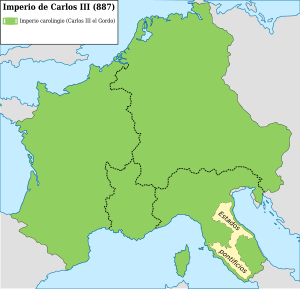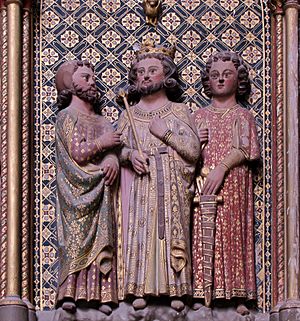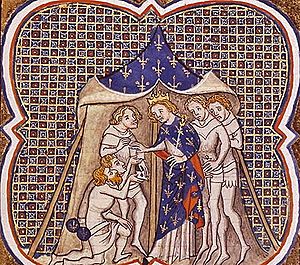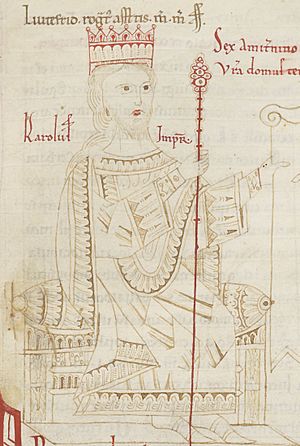Charles the Fat facts for kids
Quick facts for kids Charles the Fat |
|
|---|---|
| Emperor of the Romans | |
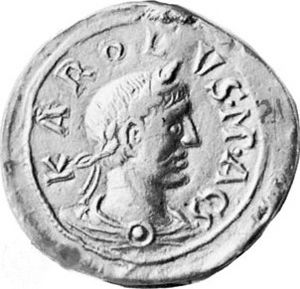
A seal of Charles the Fat with the inscription KAROLVS MAGS ("Carolus Magnus")
|
|
| Emperor of the Carolingian Empire | |
| Reign | 12 February 881 – 11 November 887 |
| Coronation | 12 February 881, Rome |
| Predecessor | Charles II (877) |
| Successor | Guy of Spoleto |
| King of West Francia and Aquitaine | |
| Reign | 12 December 884 – 11 November 887 |
| Coronation | 20 May 885, Grand |
| Predecessor | Carloman II |
| Successor | |
| King of Italy | |
| Reign | 22 March 880 – 11 November 887 |
| Coronation | 12 April 880, Ravenna |
| Predecessor | Carloman |
| Successor | Berengar I |
| King of East Francia and Alemannia | |
| Reign | 28 August 876 – 11 November 887 |
| Predecessor | Louis II |
| Successor | Arnulf |
| Co-monarchs | |
| Born | 839 Neudingen (Donaueschingen), Carolingian Empire |
| Died | 13 January 888 (aged 48–49) Neudingen (Donaueschingen), Carolingian Empire |
| Burial | Abbey of Reichenau, Lake Constance (present-day Germany) |
| Spouse | Richardis of Swabia (m. 862) |
| Issue | Bernard (illegitimate) |
| Dynasty | Carolingian |
| Father | Louis II |
| Mother | Emma of Altdorf |
| Religion | Chalcedonian Christianity |
Charles III (born 839, died 888), often called Charles the Fat, was an emperor of the Carolingian Empire. This empire was a huge kingdom in Europe. Charles was part of the famous Carolingian dynasty, which included his great-grandfather, Charlemagne. Charles was the last emperor from his family to rule over a united Frankish kingdom.
During his life, Charles slowly gained control of many parts of Charlemagne's old empire. He became ruler of Alamannia in 876. Later, he took over the Italian throne when his older brother, Carloman of Bavaria, became too sick to rule. In 881, Pope John VIII crowned him emperor. When his brother Louis the Younger died, Charles also gained control of East Francia. Finally, in 884, he inherited West Francia after his cousin Carloman II passed away. This meant Charles had reunited the entire Carolingian Empire!
However, Charles was often sick and some historians believe he had epilepsy. He sometimes paid Viking raiders to leave his lands alone, like during the famous Siege of Paris. This decision later caused problems for him.
The reunited empire did not last long. In November 887, Charles's nephew, Arnulf of Carinthia, led a rebellion. Charles was removed from power in East Francia, Lotharingia, and the Kingdom of Italy. He died a few weeks later in January 888. After his death, the empire quickly broke apart into five separate kingdoms. It would be many centuries before such a large area was united under one ruler again.
Contents
Who Was Charles the Fat?
His Nickname and Number
The nickname "Charles the Fat" (in Latin, Carolus Crassus) was not used when he was alive. It first appeared much later, in the 12th century, by a writer known as the "Saxon Annalist." There are no records from his time that describe his actual size. However, the nickname stuck and is used in many languages today.
His number, "Charles III," was used during his lifetime. A writer named Regino of Prüm, who lived at the same time as Charles, called him "Emperor Charles, third of that name and dignity."
Charles's Early Life and Family
Growing Up and Inheriting Lands
Charles was the youngest of three sons. His father was Louis the German, the first King of East Francia. His mother was Hemma from the Welf family. When he was young, it was said that he had a strange incident where he foamed at the mouth. This event deeply affected him and his father.
People described Charles as a very religious prince. He was said to fear God, follow His rules, and be very generous. He also spent a lot of time praying and singing praises to God.
In 859, Charles became the Count of the Breisgau. This was a border area in Alemannia, next to southern Lotharingia. In 863, his oldest brother, Carloman of Bavaria, rebelled against their father. The next year, Louis the Younger joined the rebellion, and Charles also joined him. Carloman was given control of the Duchy of Bavaria.
In 865, their father, Louis the German, had to divide his remaining lands among his sons. Saxony, Franconia, and Thuringia went to Louis the Younger. Alemannia (which included the Duchy of Swabia and Rhaetia) went to Charles. Lotharingia was to be split between the two younger brothers.
In 875, Emperor Louis II died. He was also the King of Italy. Louis II had agreed with Louis the German that Carloman would take over Italy. However, Charles the Bald of West Francia invaded Italy and crowned himself king and emperor. Louis the German sent Charles, and then Carloman, with armies to Italy. These efforts were not successful until Charles the Bald died in 877.
In 876, Louis the German died. His lands were divided as planned after a meeting at Ries. Charles received his share, though a bit less of Lotharingia than expected. Charles's rule in Germania (East Francia) officially began with this inheritance in 876.
Becoming Emperor
Taking Control of Italy
The three brothers, Charles, Carloman, and Louis the Younger, worked together. They avoided wars over their shared inheritance, which was rare in the Early Middle Ages. In 877, Carloman finally inherited Italy from his uncle, Charles the Bald. Louis the Younger divided Lotharingia and offered a third to Carloman and a third to Charles. In 878, Carloman gave his share of Lotharingia back to Louis, who then split it evenly with Charles.
In 879, Carloman became too sick to rule due to a stroke. He divided his lands between his brothers: Bavaria went to Louis, and Italy went to Charles. Charles considered his rule in Italia (Italy) to start from this point. He spent most of his time in Italy until 886.
In 880, Charles joined Louis III of France and Carloman II, who were joint kings of West Francia. They tried to capture Boso of Provence in Vienne, but they failed. Provence had rebelled under Boso. In August 882, Charles sent Richard, Duke of Burgundy, to take the city. Richard finally succeeded in September. After this, Boso was mostly confined to the area around Vienne.
Crowned Emperor
On July 18, 880, Pope John VIII wrote to Guy II of Spoleto asking for peace. But Guy ignored him and invaded the Papal States. The Pope then asked Charles for help, since Charles was the king of Italy. On February 12, 881, Pope John VIII crowned Charles emperor. People hoped this would bring a new era of peace to western Europe, but Charles was not able to handle the challenges. Charles did little to help against Guy II. The Pope continued to ask Charles for action even in November.
As emperor, Charles started building a new palace in Sélestat in Alsace. He designed it like the Palace at Aachen built by Charlemagne. Charles wanted to be like Charlemagne. Since Aachen was in his brother's kingdom, Charles needed a new palace in his own power base in western Alemannia. Sélestat was also a more central location than Aachen.
In February 882, Charles held a meeting in Ravenna. The duke, emperor, and pope made peace. Guy and his uncle, Guy of Camerino, promised to return the Pope's lands. But in a letter to Charles in March, the Pope said the promises were not kept. In 883, Guy of Camerino, now the duke of Spoleto, was accused of treason at a meeting in Nonantula. He went back to Spoleto and made an alliance with the Saracens. Charles sent Berengar to fight Guy III. Berengar was doing well until a widespread disease hit Italy. It affected the emperor, his staff, and Berengar's army, forcing them to retreat.
In 883, Charles signed a treaty with Giovanni II Participazio, the Doge of Venice. The treaty stated that anyone who killed a doge and fled to the Empire would be fined 100 pounds of gold and sent away.
Ruling East Francia
In the early 880s, some Viking raiders who had been defeated by Alfred the Great in 878 started settling in the Low Countries. Charles's brother, Louis the Younger, had fought them with some success. But Louis died on January 20, 882, leaving his throne to Charles. This reunited the entire East Frankish kingdom.
After returning from Italy, Charles held a meeting in Worms to deal with the Vikings. Armies from all over East Francia gathered in the summer. They were led by Arnulf, Duke of Carinthia, and Henry, Count of Saxony. The main Viking camp was then surrounded at Asselt. Charles then started talking with the Viking chiefs, Godfrid and Sigfred. Godfrid agreed to become a Christian and Charles's loyal follower. He married Gisela, the daughter of Lothair II of Lotharingia. Sigfred was paid off to leave. No one at the time criticized Charles's actions during this campaign.
In 885, Charles feared Godfrid and his brother-in-law, Hugh, Duke of Alsace. So Charles arranged a meeting at Spijk where the Viking leader fell into his trap. Godfrid was executed, and Hugh was blinded and sent to Prüm.
From 882 to 884, the Wilhelminer War took place in the March of Pannonia (later March of Austria). Arnulf of Carinthia, Charles's nephew, allied with the rebel Engelschalk II against Aribo of Austria. Aribo was Charles's appointed ruler of the region. Svatopluk I, the ruler of Great Moravia, agreed to help Aribo. In 884, at Kaumberg, he swore loyalty to Charles. Even though the emperor lost some allies, he gained powerful new friends in the Moravian leader and other Slavic leaders in the area.
Ruling West Francia
When Carloman II of West Francia died on December 12, 884, the nobles of the kingdom invited Charles to become their king. Charles happily accepted. This was the third kingdom to "fall into his lap." According to the Anglo-Saxon Chronicle, Charles took over all of Carloman's kingdom except Brittany.
It is likely that Charles was crowned by Geilo, Bishop of Langres, as rex in Gallia (king in Gaul). This happened on May 20, 885, at Grand in southern Lorraine. Charles's rule in the West was not very hands-on. He left most daily tasks to the high-ranking nobles.
Even though West Francia (which later became France) was less threatened by Vikings than the Low Countries, it was still heavily attacked. In 885, a huge Viking fleet led by Sigfred sailed up the Seine river. They then besieged Paris. Sigfred again demanded money, but this time Charles refused. Charles was in Italy at the time. Odo, Count of Paris, managed to get some men through enemy lines to ask for Charles's help. Charles sent Henry of Saxony to Paris.
In 886, as disease spread through Paris, Odo himself went to Charles for support. Charles brought a large army and surrounded the army of Rollo. He set up a camp at Montmartre. However, Charles did not intend to fight. He allowed the attackers to go up the Seine to raid Burgundy, which was rebelling. When the Vikings left France the next spring, Charles gave them 700 pounds of silver as promised. Charles's reputation in France was greatly damaged by this.
Charles issued several official documents for people in West Francia during his stay in Paris. He confirmed rights and privileges granted by earlier rulers. He had contact with Nantes when the Breton duke Alan I was powerful there. It is possible that Charles allowed Alan to be called rex (king). As emperor, he would have had this power.
Succession Challenges
Charles and his wife, Richgard, had no children. In 885, Charles tried to have his illegitimate son, Bernard, recognized as his heir. Bernard's mother is unknown. However, several bishops opposed this idea. Charles had the support of Pope Hadrian III, whom he invited to a meeting in Worms in October 885. But the Pope died on his way there. Hadrian was going to remove the opposing bishops for Charles and make Bernard legitimate. It is likely that Charles planned to make Bernard King of Lotharingia.
After this first attempt failed, Charles tried again. He started adding the word proles (offspring) to his official documents. This was likely an attempt to make Bernard seem more legitimate. In early 886, Charles met the new Pope Stephen V. They probably discussed recognizing his illegitimate son as heir. A meeting was planned for April and May of the next year at Waiblingen. Pope Stephen canceled his attendance on April 30, 887.
Nevertheless, at Waiblingen, Berengar came in early May 887. He had lost the emperor's favor after a brief disagreement. He made peace with the emperor and gave great gifts to make up for his past actions.
Charles eventually gave up his plans for Bernard. Instead, he adopted Louis of Provence as his son at a meeting in Kirchen in May. However, this agreement with Louis might have only been to gain support for Bernard to be a sub-king in Lotharingia. In June or July, Berengar arrived in Kirchen. He probably hoped to be declared Charles's heir. He might have even been named heir in Italy, where he was acclaimed king right after Charles was removed from power. Odo, Count of Paris, might have had a similar goal in visiting Charles at Kirchen.
Removal from Power, Death, and What Happened Next
As Charles was increasingly seen as weak and ineffective, problems grew in late 887. In the summer of that year, Charles gave up on plans for his son's succession. He welcomed Odo and Berengar, Margrave of Friuli, a relative, to his court. He might have accepted one or both of them as his heir in their respective kingdoms. His closest advisors then began to turn against him.
In that year, his first cousin once removed, Ermengard of Provence, brought her son Louis the Blind to him for protection. Charles confirmed Louis as ruler in Provence and allowed them to live at his court. He probably intended to make Louis heir to the entire empire. On November 11, he called a meeting in Frankfurt. While there, he received news that his ambitious nephew, Arnulf of Carinthia, had started a rebellion. Arnulf was marching into Germany with an army.
The next week, Charles lost all support in East Francia. His loyal Alemanni were the last to abandon him. By November 17, Charles was no longer in power, though the exact details are unclear. He did little to stop Arnulf's move, as he had been ill again. He asked for a few estates in Swabia to live out his days. He received Naudingen (Donaueschingen). He died there six weeks later, on January 13, 888.
The Empire fell apart and was never fully restored. According to Regino of Prüm, each part of the realm chose its own "kinglet." Arnulf likely wanted the whole empire, but he only received East Francia and Lotharingia. The French chose Odo as their king. Guy III of Spoleto also tried to become king in Italy, even though Berengar had already been crowned. Louis was crowned in Provence, as Charles had intended. Odo eventually accepted Arnulf's higher authority.
In Upper Burgundy, a leader named Rudolph was chosen as king. In Aquitaine, Ranulf II declared himself king. He took care of the young Charles the Simple, who was the Carolingian heir in the West. Ranulf refused to recognize Odo's election.
It is not known if these new kings were chosen because Charles was removed from power or because he died. Only the elections of Arnulf and Berengar definitely happened before Charles's death. Only the nobles of the East formally removed him from power. Charles was buried with honor in Reichenau. Writers of the time praised his religious devotion. Modern historians suggest that his lack of success might have been due to his constant illness.
Charles was the subject of a Latin story called the Visio Karoli Grossi. This story was written to support Louis the Blind and warn the Carolingians that their rule was not guaranteed if they did not have the Church's favor.
See also
 In Spanish: Carlos III el Gordo para niños
In Spanish: Carlos III el Gordo para niños
- Family tree of the German monarchs
Images for kids


